Part 87 United States Drug Enforcement Administration Releases 2015 National Drug Threat Assessment Summary for MDMA (3,4-Methylene dioxy meth amphetamine), ecstasy and molly, smuggling Canada, Asia, India, Eastern Europe, Mexican, stimulant, psychedelic, energizing effect, distortions in time, distortion in perception, and enhanced tactile experiences. Adolescents, sniffing, snorting, orally, smoked, liquefied and injected. DEA ICE FDA
[Smuggling Mexico DEA ICE FDA2015 Drug Threat Assessment Continued from Part 86 Synthetic Designer Drugs]
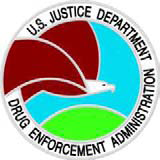
2015 National Drug Threat Assessment UNCLASSIFIED
MDMA (3,4-Methylene dioxy methamphetamine)
The US Drug Enforcement Administration 2015 National Drug Threat Assessment (NDTA) is a comprehensive report of the threat posed to the United States by the trafficking and abuse of illicit drugs, the nonmedical use of CPDs, [Controlled Prescription Drugs] , money laundering, TCOs [Transnational Criminal Organization] , gangs , smuggling, seizures, investigations, arrests, drug purity or potency, and drug prices, in order to provide the most accurate data possible to policymakers, law enforcement authorities, and intelligence officials.
Part 87 United States Drug Enforcement Administration Releases 2015 National Drug Threat Assessment Summary for MDMA (3,4-Methylene dioxy meth amphetamine), ecstasy and molly, smuggling Canada., Asia, India, Eastern Europe, Mexican, stimulant, psychedelic, energizing effect, distortions in time and perception, and enhanced tactile experiences. Adolescents, sniffing or snorting, orally, smoked, or liquefied and injected.
(U) Photo 22. MDMA Source: DEA
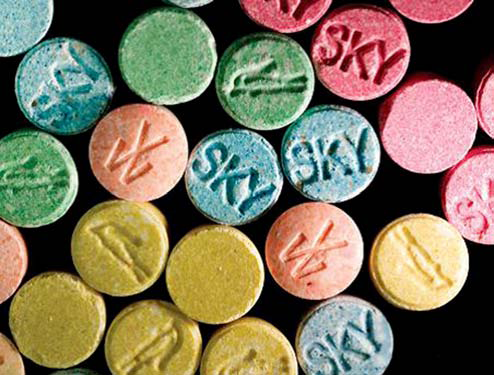
Overview Methylene dioxy methamphetamine
MDMA, a synthetic Schedule I drug commonly referred to as “ecstasy” and “molly”, is available throughout the United States. Compared to marijuana, cocaine, heroin, and other illicit drugs, the MDMA market in the United States is small. Most of the MDMA seized in the United States is manufactured in clandestine laboratories in Canada and smuggled across the Northern Border. Canada-based Asian TCOs are the primary suppliers of MDMA in the United States, producing tens of millions of tablets for the US market. (See Photo 22.) MDMA acts as both a stimulant and as a psychedelic. It produces an energizing effect, distortions in time and perception, and enhanced enjoyment of tactile experiences.
DEA reporting indicates the sources of supply for “molly” are either US-based rogue chemists or foreign-based traffickers from China and, to a lesser extent, India and Eastern Europe. “Molly” is often ordered from Internet websites using Bitcoin for payment.
Availability Methylene dioxy methamphetamine
MDMA is available throughout the United States, but availability is generally declining. The only respondents to the 2015 NDTS to report an increase in MDMA availability from the previous year were the Southeast and the Southwest OCDETF regions. Nationally, 7.3 percent of law enforcement agencies surveyed indicated that MDMA availability was at high levels in their jurisdiction. However, the data indicate that MDMA is significantly more available in certain regions. (See Table 12.)
(U) Table 12. 2015 NDTS Respondents Reporting High Availability of MDMA, by Region (Percentage)
2014, 2015
OCDETF Region Source: National Drug Threat Survey
Florida/Caribbean 20.6 18.0
Great Lakes 7.5 2.3
Mid-Atlantic 5.3 2.9
New England 12.4 4.4
New York/New Jersey 15.1 13.1
Pacific 10.7 8.0
Southeast 10.3 11.6
Southwest 5.5 11.8
West Central 5.4 2.3
Nationwide 8.8 7.3
(U) Photo 22. MDMA
The drug “molly” is purported to be a pure form of MDMA—free of any added substances—but the true chemical make-up of “molly” varies. Drugs marketed or sold as “molly” are often made up of several different substances, including synthetic cathinones such as methylone, and do not always contain MDMA. (Methylone is a Schedule I controlled substance and is commonly imported from China via the Internet for use in the United States.)
Intelligence indicates that some tablets sold as “ecstasy” or “molly” may not be MDMA at all, but another chemical or a mixture of various chemicals which may or may not contain MDMA. DEA laboratories have analyzed samples that have contained methamphetamine, ketamine, caffeine, dimethylsulfone, N-benzylpiperazine (BZP), and trifluoromethylpiperazine (TFMPP), in addition to MDMA.
[85]
Use MDMA
Demand data indicate that MDMA use is generally on the decline. According to NSDUH, while the number of people reporting both lifetime and current use of MDMA has increased, the number reporting past year use has decreased. (See Table 13.) Additionally, MTF data show that past year MDMA use has declined in each of the grades (8th, 10th, and 12th) surveyed.
MDMA is generally used by adolescents and college-aged youths. NSDUH data indicate that 69.4 percent of the MDMA initiates in 2013 were aged 18 or older at the time they first used MDMA.
(U) Table 13. National Survey on Drug Use and Health, MDMA Initiates, 2009 – 2013
2009 2010 2011 2012 2013
Past Month Use 763,000 691,000 544,000 628,000 660,000
Past Year Use 2,804,000 2,653,000 2,422,000 2,610,000 2,588,000
Lifetime Use 14,280,000 15,929,000 14,570,000 16,162,000 17,815,000
Source: National Survey on Drug Use and Health
Canada continues to be the primary source country of MDMA for domestic use in the United States. Investigative reporting and intelligence indicate that Canada-based Asian TCOs continue to dominate the production and distribution of MDMA. These TCOs manufacture wholesale quantities of MDMA in clandestine laboratories located in Canada, producing tens of millions of tablets. MDMA production takes place predominantly in British Columbia; however, it is also manufactured in smaller quantities in Ontario and Quebec. While seizures along the US–Canada border have declined from the peaks seen in 2008 and 2009, the smuggling of MDMA from Canada into the United States remains a threat.
(U) Chart 36. Number of MDMA Domestic Cases Opened and Arrests by DEA2007 – 2014 Source: DEA
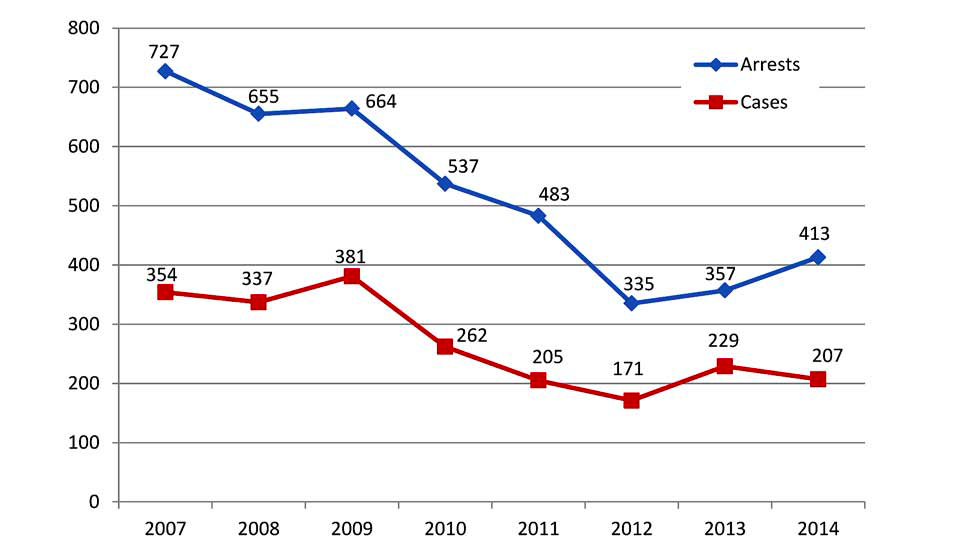
Transportation Methylene dioxy methamphetamine
Asian TCOs smuggle MDMA across the border using various methods and modes of transportation such as personal vehicles, commercial trucks, buses, planes (small personal planes and helicopters as well as couriers on commercial airlines), trains, vessels, all-terrain vehicles, and snowmobiles. In addition, TCOs recruit individuals at and between POEs along the entire US–Canada border to carry the drug on their persons. There are five major corridors used by drug traffickers to smuggle illicit drugs. These areas are in the vicinity of Blaine, Washington; Detroit, Michigan; Champlain and Buffalo, New York; and to a lesser degree, the Saint Regis Mohawk Reservation, on the St. Lawrence River which is used by TCOs in Ontario and Quebec to smuggle MDMA into the United States.
Distribution Methylene dioxy methamphetamine
Asian organizations dominate the trafficking of MDMA in the United States and collaborate with various US street gangs and OMGs to facilitate distribution of the drug. Recent DEA reporting indicates that Mexican organizations traditionally involved in cocaine, methamphetamine, and marijuana trafficking are now obtaining MDMA from Canada and selling wholesale amounts (1,000 tablets or more) to local drug traffickers in the United States.
(U) Operation Northern Exposure Dismantles MDMA Trafficking Organization
In October 2014, seven members of a Canada-based TCO were arrested on charges of international MDMA distribution and money laundering in connection with OCDETF investigation Operation Northern Exposure. This TCO shipped multi-thousand dosages of MDMA via package delivery services to numerous distributors in the Denver metro area. The tablets were multi-colored and often shipped intermixed with popular brands of candy in an effort to avoid law enforcement detection. Several bank accounts in Canada, China, and the United States were tied to the organization, leading to money laundering charges. Three members of the organization were arrested in Colorado and four were arrested in Canada.
(U) Photo 24. MDMA concealed in commercial candy
Source: DEA
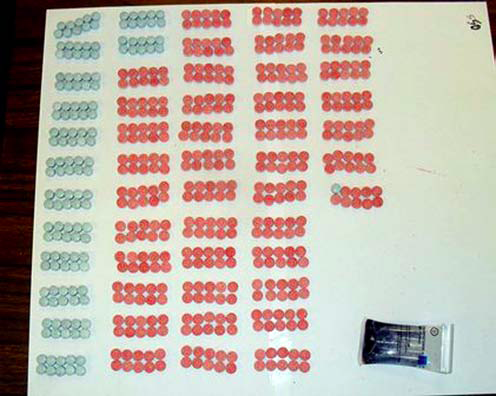
(U) Photo 23. Seized MDMA
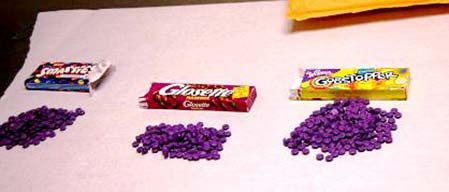
(U) Photo 24. MDMA concealed in commercial candy Source: DEA
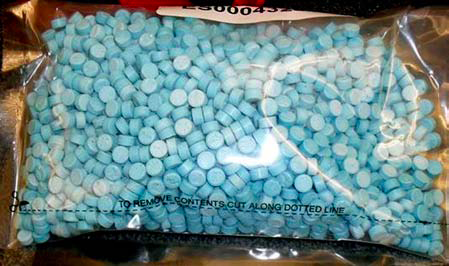
(U) Photo 25. 6,000 MDMA pills purchased in Vancouver, Canada Source: DEA [87]
The number of DEA MDMA cases and arrests declined significantly between 2007 and 2014, although there was a slight increase in arrests and cases opened between 2012 and 2014. (See Chart 36.)
MDMA is usually distributed in tablet form with logos that create brand names for users to seek out. However, the drug is also available in capsule, powder, and liquid forms. MDMA is considered a “party drug” and is often mixed with other substances such as alcohol and marijuana. While it is most commonly used by adolescents and college-aged young adults, it is no longer considered exclusively a rave or club drug, and is used by nontraditional groups.
Drugs sold as “molly” are usually sold in powder form and can be white, off-white, brown, yellow, or pink in color. “Molly” also can be sold in gel capsules. (See Photo 26.)
(U) Photo 26. “Molly” in gel capsules Source: DEA
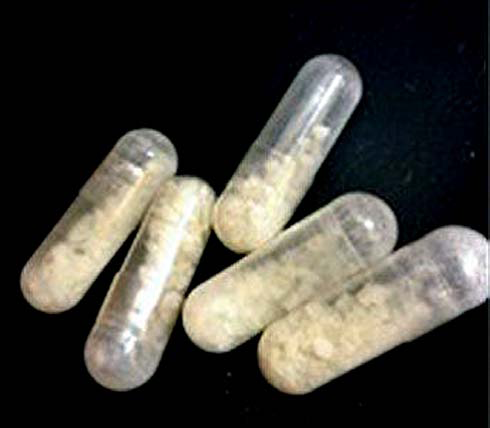
“Molly” is typically fine in texture, but another form of the drug is known as “moon rocks,” and is chunkier in appearance. (See Photo 27.)
(U) Photo 26. “Molly” in “Moon Rock” form Source: DEA
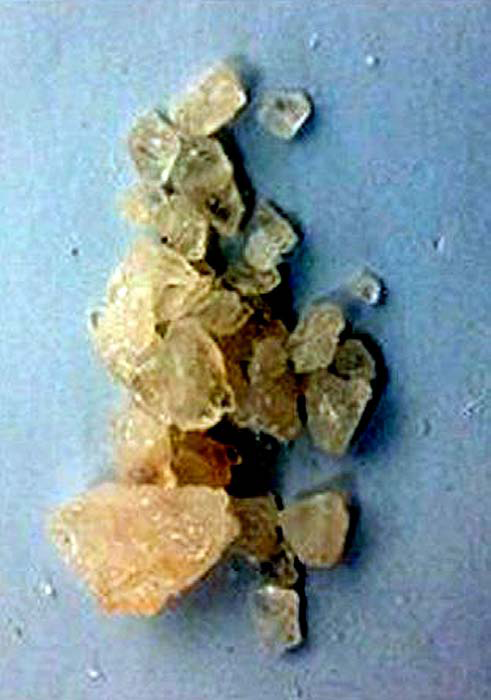
Moon rocks are a crystalized form of MDMA, usually yellow or white in color and similar in appearance to crack cocaine. “Molly” can be ingested by sniffing or snorting, orally, smoked, or liquefied and injected. Some consume “molly” by a method known as “parachuting,” whereby the powder is wrapped in a facial tissue and then swallowed. As the tissue slowly dissolves, the “molly” is introduced into the stomach.
Outlook Methylene dioxy methamphetamine
MDMA and “molly” will pose a continuing, albeit relatively low, threat to the United States, particularly to young people. MDMA and “molly” are inexpensive and easy to obtain and will continue to be popular drugs of use among high school and college students, as well as young adults who attend concerts, clubs, and music events.
Disclaimer: The author of each article published on this web site owns his or her own words. The opinions, beliefs and viewpoints expressed by the various authors and forum participants on this site do not necessarily reflect the opinions, beliefs and viewpoints of Utah Standard News or official policies of the USN and may actually reflect positions that USN actively opposes. No claim in public domain or fair use. © Edmunds Tucker. UTopiAH are trade marks of the author. Utopia was written in 1515 by Sir Thomas More, Chancellor of England.
[2015 Drug Threat Assessment continues next at Part 88 Phencyclidine]
Utah Standard News depends on the support of readers like you.
Good Journalism requires time, expertise, passion and money. We know you appreciate the coverage here. Please help us to continue as an alternative news website by becoming a subscriber or making a donation. To learn more about our subscription options or make a donation, click here.
To Advertise on UtahStandardNews.com, please contact us at: ed@utahstandardnews.com.


Comments - No Responses to “Part 87 United States Drug Enforcement Administration Releases 2015 National Drug Threat Assessment Summary for MDMA (3,4-Methylene dioxy meth amphetamine), ecstasy and molly, smuggling Canada, Asia, India, Eastern Europe, Mexican, stimulant, psychedelic, energizing effect, distortions in time, distortion in perception, and enhanced tactile experiences. Adolescents, sniffing, snorting, orally, smoked, liquefied and injected. DEA ICE FDA”
Sure is empty down here...